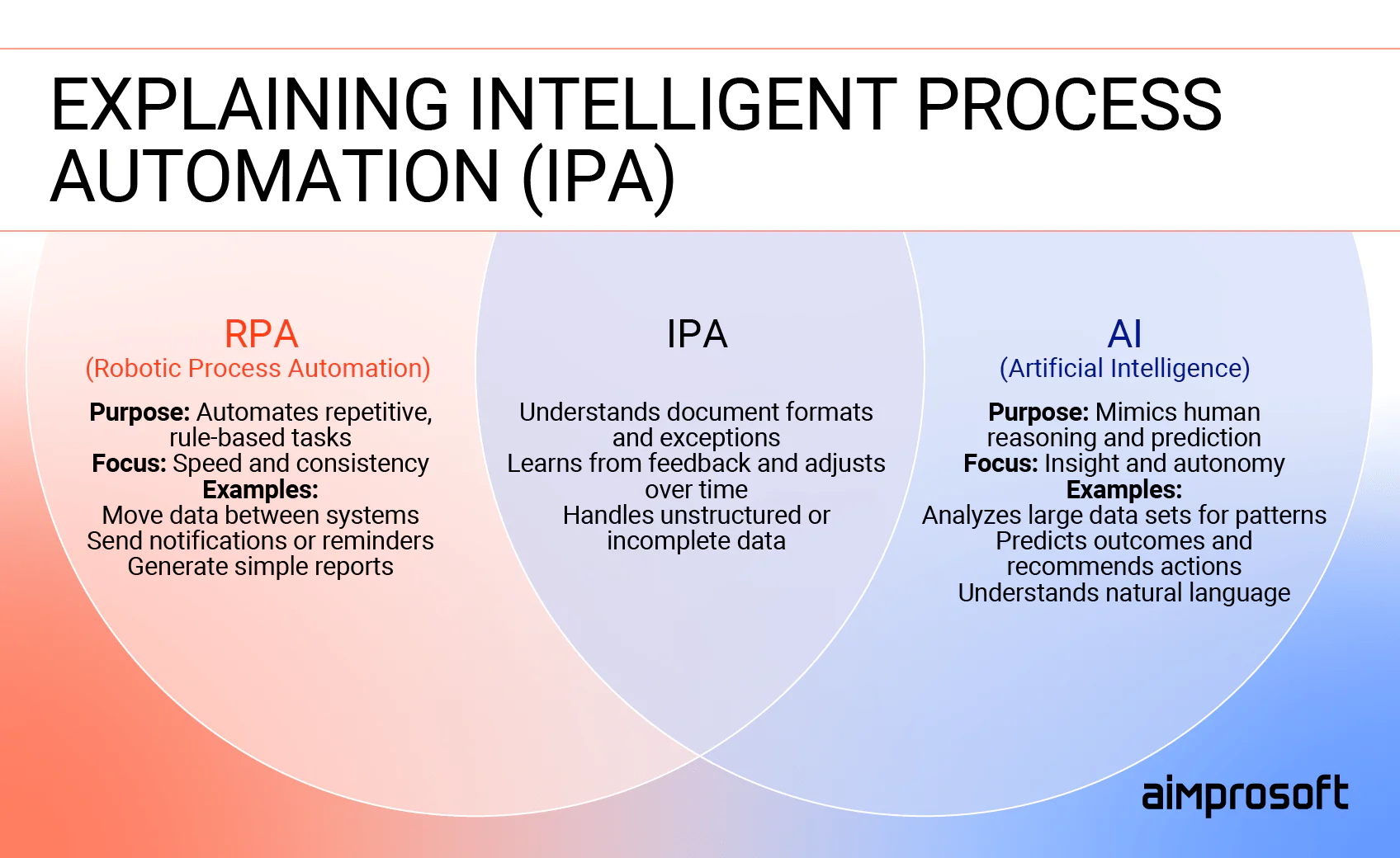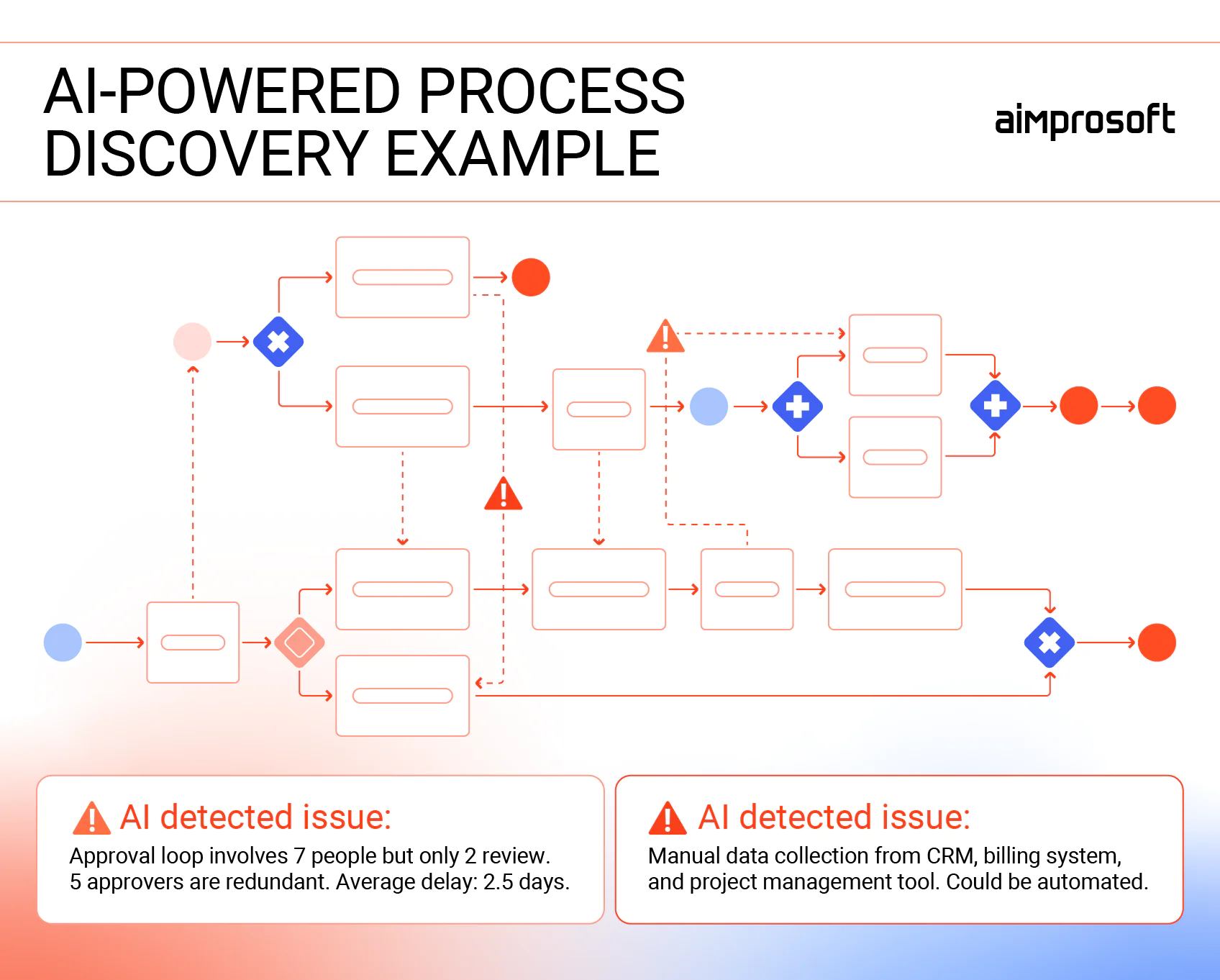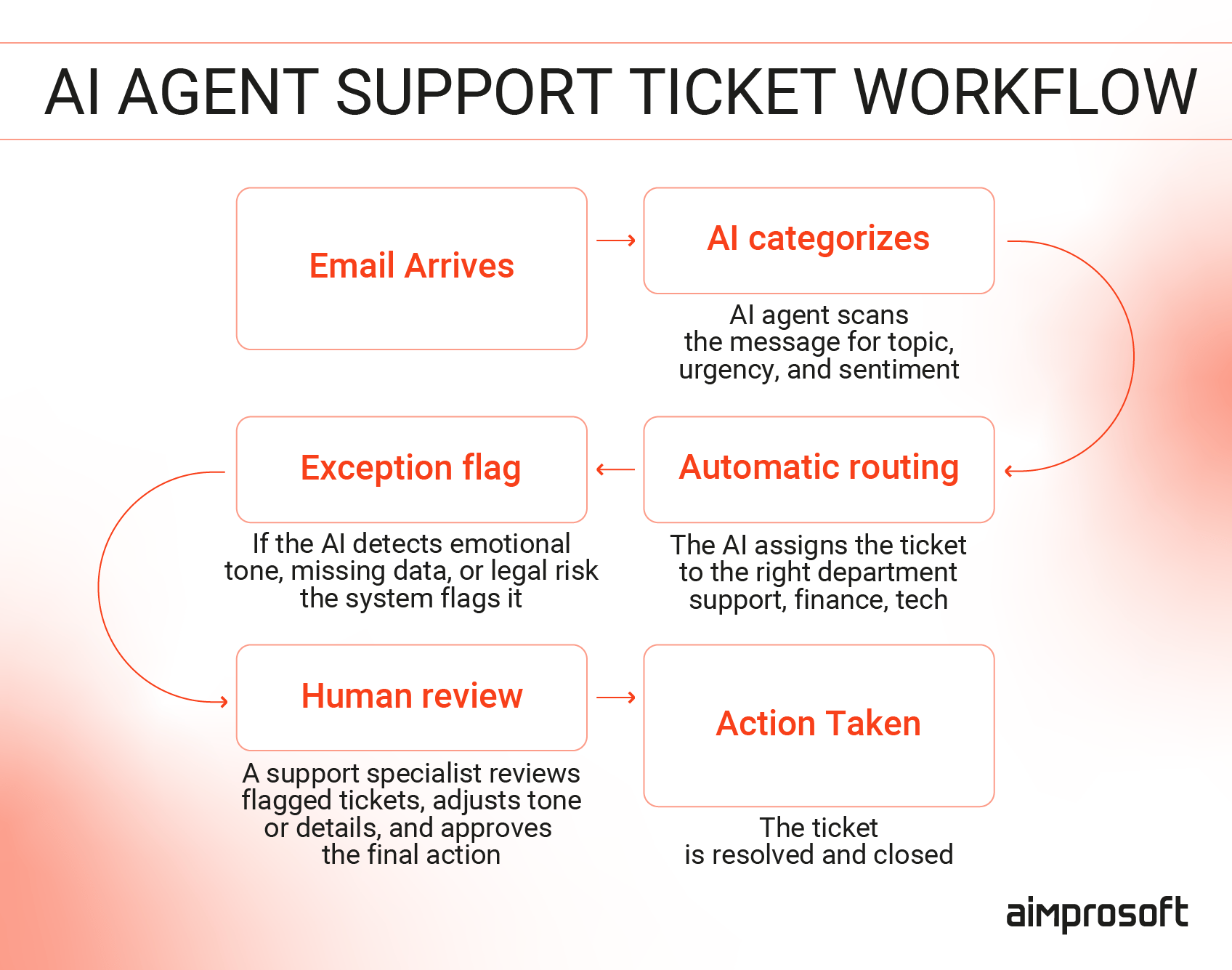The Future of Business Process Automation: AI Trends to Watch in 2026
An open market from the start means competition. And when several companies sell identical products, the product itself can’t change—differentiation shifts from what you do to how you do it. Speed, efficiency, and intelligence are the new competitive factors.
And for SMBs, intelligent business automation offers a practical way to turn everyday operations into a genuine competitive advantage.
But, as AI capabilities evolve, trends in automation change too. What worked last year (basic task automation and rule-based workflows) is already being replaced by more adaptive, data-driven, and predictive systems.
Below, we look at five business process automation trends shaping 2026—what’s driving them, why they matter for SMBs, and what to consider before diving in. Our goal here is simple: help you decide which trends are worth your investment and which ones you can skip.
Let’s get into it.
Key emerging technologies in business automation for 2026
AI has blurred the line between automation and optimization. Both promise to “make things better,” both involve “smart systems,” and both get sold with the same pitch deck. For many organizations, this distinction has become functionally meaningless.
But the distinction matters. Automation replaces manual steps. Optimization improves how work gets done. AI can do both simultaneously, which sounds ideal—until you realize most companies don’t understand their internal processes. That’s why, despite billions of investments in Gen AI, only 5% of pilots deliver measurable business returns (MIT). It’s not technology’s fault; it’s bad preparation.
The real question for companies here should be: “Do you understand your processes well enough to know which one you need to either optimize or automate?” And if you haven’t evaluated your current workflows yet, here’s how to identify which business processes to automate first.
Once you have that clarity, the next step is to understand which emerging technologies in business automation fit your needs.
#1 Intelligent Process Automation (IPA)
Traditional robotic process automation (RPA) tools are designed for defined, rule-based processes: if X happens, do Y. They’re fast and reliable for repetitive tasks, but they break when something unexpected occurs. Intelligent Process Automation (IPA) builds on that foundation, adding AI, machine learning, and digital process automation to handle what RPA can’t—exceptions and variations.
What makes IPA a priority of AI trends in business automation this year is its shift from rule-following to context-understanding. Instead of automating fixed steps, these systems recognize patterns, adapt to changes, and improve over time. For SMBs implementing AI automation for business, this means fewer rigid workflows and more responsive operations that adjust to real-world conditions like customer behavior, market shifts, or supply chain delays.

Where IPA delivers value:
- Invoice processing: handles invoices in any format—scanned PDFs, email attachments, vendor portals—without requiring rigid templates. Flags anomalies (duplicate charges, unusual amounts) and routes exceptions to the right person automatically.
- Customer onboarding: automates document verification, compliance checks, and account setup across multiple systems. Unlike RPA, it adapts to different ID formats, document types, and jurisdictional requirements without breaking.
- Claims processing: assesses non-standard claims that don’t fit predefined rules, detects potential fraud patterns, and escalates edge cases to human reviewers—handling the variations that would stop traditional automation.
What it doesn’t solve:
Despite being among the most promising intelligent automation trends, IPA doesn’t fix poor process design or automatically orchestrate disconnected systems into coherent workflows. If the workflow itself is flawed, AI in workflow automation will just replicate that fragmentation faster.
As our Business Analysts often say, “Small automations are easy to build. What’s harder is connecting them into workflows that deliver measurable results.” IPA addresses part of that gap by handling exceptions, but it’s not a magic orchestration layer. You still need to design the process.
#2 Predictive and prescriptive analytics
For years, businesses have relied on historical reports to understand what happened in the last quarter and used those insights to plan their next steps. Predictive analytics automates that process, using historical data and AI models to forecast likely outcomes. Prescriptive analytics goes even further, enabling AI-driven decision-making by recommending the best next steps based on predictive insights.
Why is it one of the AI trends 2026? AI has made these capabilities accessible for SMBs. What used to require data science teams and expensive infrastructure is now available as AI automation for small business through platforms like Salesforce Einstein, Microsoft Power BI, or HubSpot. Tools SMBs already use. These systems come with pre-built models, require minimal technical setup, and operate on a subscription pricing model rather than a massive upfront investment.

Where predictive and prescriptive analytics deliver value:
- Inventory optimization: predicts demand spikes based on seasonal patterns, market trends, and external factors, then automatically suggests reorder quantities and timing.
- Customer churn prevention: identifies at-risk customers weeks before they leave and recommends specific retention tactics based on their behavior patterns.
- Cash flow forecasting: predicts shortfalls or surpluses weeks in advance and suggests concrete actions like adjusting payment terms or timing capital expenditures.
- Dynamic pricing: adjusts prices in real-time based on demand predictions, competitor moves, inventory levels, and margin targets.
What it doesn’t solve:
Predictive models are only as good as the data you feed them. If your data is siloed across disconnected systems, incomplete, or poorly structured, even advanced AI business process automation will generate unreliable predictions.
Moreover, prescriptive recommendations assume your organization can actually act on them. If you lack the operational flexibility to adjust pricing quickly, even perfect predictions won’t drive results.
It’s important to note that the tools can analyze patterns and suggest actions faster than any human. But even with AI-driven insights for business decision-making, someone still needs to validate whether the recommendations fit your specific context and whether your organization can actually act on them.
#3 AI-Powered process discovery and optimization
Many automation projects fail because teams start from assumptions, not evidence. They automate what they think happens instead of what actually happens. AI-powered process discovery changes that by analyzing digital footprints—logs, user actions, and timestamps—to map how work truly flows across tools and teams. This evidence-based approach is what separates effective business process automation using AI from projects that automate the wrong things.
Think of it as process mining with an upgrade. Traditional tools visualize workflows. AI-driven ones learn from them, spotting recurring bottlenecks, predicting where delays are likely, and highlighting the steps that create noise instead of value in AI automation business operations.

Where AI-powered process discovery delivers value:
- Pre-automation assessment: maps actual workflows to identify which processes are standardized enough to automate and which have too many variations, preventing expensive automation failures before they happen.
- Compliance and audit trails: automatically documents how processes run versus how they’re supposed to run, surfacing deviations in real-time without manual process reviews.
- Continuous optimization: identifies emerging bottlenecks as they develop rather than waiting for quarterly reviews. Catching inefficiencies early when they’re still small and fixable.
- Cross-system workflow mapping: tracks how work moves across your tech stack—CRM, email, collaboration tools, spreadsheets—uncovering hidden handoffs and delays that don’t show up in any single system.
What it doesn’t solve:
Process discovery shows you what’s happening, but it doesn’t tell you what to do about it. The tools excel at surfacing problems: this step takes 3x longer than it should, this handoff creates a two-day delay, this approval loop involves seven people but only two actually review anything. But interpreting whether those problems are worth solving requires business judgment. Human business judgement.
This is the limitation of intelligent automation in business. Maybe that three-day delay exists because the legal needs time to review contracts properly. Maybe those seven approvers are there for regulatory reasons. That’s why it’s so important for companies exploring AI for business automation to pay attention to this point.
Get a personalized AI Automation Audit from our team.
#4 Industry-specific AI platforms
For years, the standard approach was to buy a general-purpose platform—Salesforce, SAP, Microsoft Dynamics—and spend months customizing it to fit your industry. Add fields for patient records and you’re in healthcare. Build custom workflows for claims processing—you’re now working in insurance. Configure approval chains for regulatory compliance and, congrats, you’re in finance.
But in 2026 shift is toward vertical AI platforms—tools built specifically for one industry from the ground up, rather than adapted from general-purpose software. This represents a pivotal moment in the future of business process automation. What were once feature-limited niche tools are now well-funded, technically sophisticated alternatives that deploy faster and cost less than customized horizontal solutions. Companies are voting with their budgets: the vertical AI market is projected to grow from $10.2 billion in 2024 to $69.6 billion by 2034.
A manufacturing AI platform already understands production scheduling, quality control protocols, and supply chain integration. A retail platform knows inventory turnover patterns, seasonal demand forecasting, and POS system requirements—all out-of-the-box, delivering intelligent automation for business without extensive customization.

Where industry-specific AI delivers value:
- Legal services: document automation and case management with built-in regulatory requirements, standard clause libraries, and jurisdiction-specific filing rules. Eliminates months of customization for compliance workflows.
- Healthcare: patient management systems that understand clinical workflows, billing code requirements, and HIPAA compliance from day one. No need to build medical record structures or configure insurance claim logic.
- Logistics: route optimization and warehouse management pre-integrated with major carriers, customs documentation requirements, and delivery exception handling. Connects these systems automatically rather than one by one.
- Financial services: lending platforms with built-in credit decisioning models, regulatory reporting requirements, and KYC/AML compliance checks. Avoids manual configuration of every regulation.
What it doesn’t solve:
To be clear, horizontal platforms aren’t obsolete. They still win when flexibility matters more than speed. As an AI for business automation solution, vertical platforms nail 80% of workflows. The challenge is the other 20%—the unique processes that differentiate your business.
If your competitive advantage comes from doing things differently than your competitors, forcing those processes into industry-standard software might eliminate what makes you special. But if your advantage comes from executing standard processes better than others, vertical platforms can accelerate that execution. Your task here is to choose which applies to your business.
#5 Autonomous AI agents
AI agents can monitor Slack, detect escalations, create Jira tickets, assign them to the right team, and notify stakeholders—all without human touch. In theory, the next step beyond automation is that software should manage itself. This vision drives many of the AI automation trends in 2026.
But as our Business Analyst likes to say, autonomy isn’t the same as accountability. Many companies rush to “replace” people with agents and end up with errors they can’t explain or reverse. Early adopters quickly learn that most “autonomous” tools still need someone to review context, handle exceptions, or simply confirm that an AI didn’t make a wrong assumption.
For SMBs seeking to benefit from AI-powered business transformation, the most effective use of AI agents is supervised delegation. When you let agents handle routine actions, while humans validate outcomes. This approach to AI for business process automation balances efficiency with control.
Here’s what that looks like: a support agent triages incoming emails, categorizes them, assigns priority, and routes them automatically. But it flags unusual cases (angry language, VIP customers, legal threats) for human review before taking action.
Shortly, the AI handles 80% autonomously, while humans validate the 20% where context matters.

Where autonomous AI agents deliver value:
- Support ticket triage: reads incoming requests, categorizes them by urgency and type, routes them to the right team, and drafts initial responses. Handles hundreds of tickets per day without human intervention.
- CRM maintenance: monitors customer interactions across email, calls, and meetings to update records automatically and trigger follow-up workflows based on deal stage or engagement patterns.
- Meeting documentation: joins video calls, generates summaries with action items and decisions, then distributes them to participants. No more dedicated note-takers or post-meeting recap work.
- Data enrichment: pulls information from LinkedIn, company websites, and news sources to update lead records and surface relevant context before sales calls. Reduces research time from hours to seconds.
Where it doesn’t work:
Agents fail when error costs exceed automation value. That includes high-stakes decisions (contracts, financial commitments), ambiguous contexts where “it depends” is the usual answer, and black-box operations where no one can explain why the agent acted.
Before deploying agents, ask: Can we clearly define success? How quickly will we catch mistakes? Who’s accountable when something breaks?
In 2026, autonomous agents will expand, but so will the demand for people who can design their boundaries and validate their outputs.
So, what’s next?
Business process automation trends may define the landscape, but it doesn’t mean they are equally urgent for every business. The real question isn’t which one to adopt first; it’s if it will solve issues you’re having right now.
That doesn’t mean ignoring these developments. It means approaching them as part of the automation strategy for 2026, not just an abrupt reaction.
- Start by understanding what you already have before adopting the latest trends in business process automation. Map your current automation landscape. What’s working? What’s breaking? Where are teams building manual workarounds? This clarity shows you which processes are ready for AI, and which need foundational fixes first.
- Then, identify where AI automation for business can create a real impact. Not every process benefits from automation in digital transformation, and not every trend fits your operations. Focus on the areas where intelligent business automation can eliminate recurring bottlenecks—such as customer onboarding delays, inventory prediction gaps, and compliance documentation overhead—rather than automating for the sake of automation.
- Assess whether your infrastructure can support it. AI tools need clean data, connected systems, and stable technical foundations. If your data lives in silos or your systems don’t talk to each other, even the smartest AI will struggle. Evaluate your readiness honestly before committing to the budget.
- Prepare your team for the shift. Business process automation with AI only works when people understand how to use it. Consider how you’ll help your team learn to work with AI agents, interpret predictive models, and manage automated workflows. Adoption without capability creates expensive confusion.
- Plan your investments strategically. AI adoption isn’t a single project—it’s a multi-year evolution. Budget for 2026 with an eye toward building capabilities that compound, not disconnected pilots that never scale.
- Focus on the complex problems first. The highest ROI comes from solving cross-functional challenges—the workflows that touch multiple departments, span several systems, or require coordination across teams. These are the problems where AI delivers compounding value, not just isolated efficiency gains.
If you’re working through these questions and need a second viewpoint—or if you’re dealing with integration challenges that span multiple systems and teams—we’re here to help. We specialize in complex, cross-functional automation problems that don’t fit neatly into a single tool or department.
Ready to future-proof your business with AI automation? Book a free strategy consultation with our experts.




